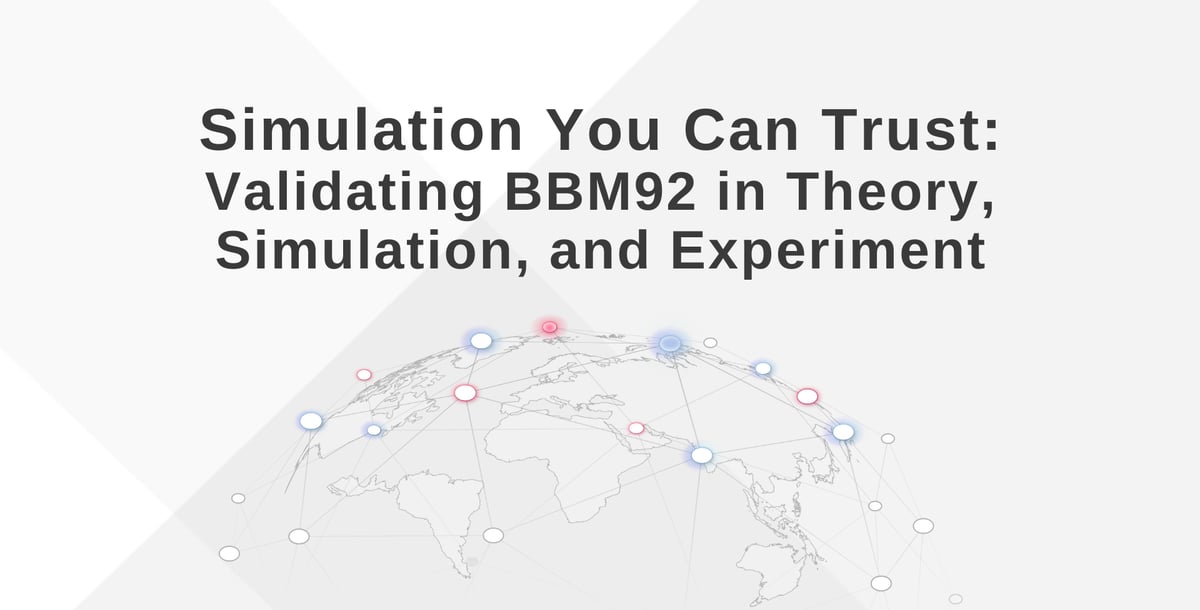
In this blog post, we give a high-level explanation of the findings of our research paper, Realistic quantum network simulation for experimental BBM92 key distribution.
The Validation Challenge
As quantum network complexity grows, tools that can reliably and accurately predict network performance become necessary for the design, development and deployment of entanglement-based networks. There are two main methods for predicting quantum network performance: theoretical modeling and discrete event simulation. These approaches each have different strengths and weaknesses. By using both methods, the best hardware can be selected for a given quantum networking, avoiding expensive dead ends. Teams evaluating entanglement-based quantum networking want concrete predictions:
- What secret key rate can be achieved over an existing fiber optic network?
- How sensitive is our quantum network design to environmental factors, such as polarization drift, dispersion, and timing jitter?
- What are the loss and noise thresholds at which secure keys can no longer be established with practicality?
Our goal with quantum network simulation is to make it simpler to predict quantum network performance, and make it easier to verify that your quantum network design supports the performance you need.
Theoretical Analysis
With theoretical analysis, hardware specifications and characterizations about the fiber network and the devices are used to estimate the quantum bit error rate (QBER) and the secure key rate by plugging these details into a theoretical model. This theoretical model could be derived from literature, or might be derived using your organization’s internal insights and assumptions. Theory excels when the systems being modeled are simple, or admit a lot of symmetry: where many parts behave the same way (e.g., each entanglement emission and key generation attempt can be modeled identically), so one calculation covers the behavior of many protocol attempts. In general, these assumptions about symmetry do not always hold, meaning that theoretical models can produce inaccurate results in certain situations.
Theoretical models are also useful for characterizing certain systems that cannot be simulated. For example: when there are infinities involved in the mathematics, simulations have trouble representing these infinitely large values. However, theoretical modeling provides approaches to attack these limits and translate them into computable problems.
Accurate Simulation
Simulation analysis starts from the same point as theory: hardware specifications and characterizations are fed into the simulation. In most cases, simulation is closely aligned with the theoretical model. Simulation excels when the simulated system is complex and requires tedious calculations to model. Furthermore, simulation can more easily operate in situations where the symmetries required by theory do not hold. In simulation, you can often get around these assumptions by modeling the system more explicitly and letting the calculation and simulation be done by the computer. This lets you explore messy situations that are more attuned to reality than theory can accommodate.
Theory and simulation are complementary techniques. Each has unique benefits, and we encourage you to use both of these methods to design real-world quantum networks.
Data from a Quantum Network
In our research, we validated the quantum network simulation against reality, by running BBM92 on Aliro’s laboratory quantum network in Boston and comparing those results to the simulator.

The setup uses an entangled-photon source connecting via single-mode fiber to Alice and Bob, passive 50:50 basis selection with a beam splitter (BS), polarization control and correction with wave plates (PC), a polarizing beam splitter (PBS) for the final measurement basis, and single-photon detectors that record timestamped clicks. Because we time-tag the detections, we can re-bin the same data under different coincidence-window widths. As the window is widened, accidental coincidences increase, QBER ticks up, and the asymptotic secure key rate falls, which is exactly the trade-off explained in the theory.
Before running BBM92, we characterized the hardware being used and input that data into the simulator and into the theoretical model: source brightness and visibility, transmission/detection efficiencies, detector dead time and dark counts, and detection-time resolution. The simulation and theory used the same parameters we observed in the lab. Using those parameters, the experiment produced counts, coincidences (including accidentals), raw key rate, and QBER, and from those parameters we computed the asymptotic secure key rate.
Alignment: Theory, Simulation, and the Experimental Quantum Network
When we overlay experiment, simulation, and theory across coincidence-window settings, the theory, simulation, and experimental quantum network agree closely.

Where differences do appear, they match the expectations:
- The theoretical model overestimates accidental counts at low-loss settings, causing theory to drift away from experiment as the coincidence window gets larger. For larger coincidence windows, the theoretical model drifts away from the experimental data on the raw key rate curve because of how the number of accidental coincidences are overcounted in order to simplify the theoretical model. (see the inset of Fig. 3 a above).
- At very narrow coincidence windows, the simulator shows wider error bars. This is due to the simulator using a Monte Carlo method, where the smaller sample size isn’t as effective at predicting behavior.
Overall, the laboratory quantum network confirms the simulator’s predictions and clarifies exactly where a simplified theoretical expression needs refinement.
By using both theoretical modeling and quantum network simulation, it’s possible to get the best of both worlds: theory gives insight and security guarantees under specific assumptions, while simulation captures the messy realities that drive real-world quantum network performance. Together, they de-risk design and speed up decisions, helping organizations move from concept to deployment with fewer surprises. For a deeper dive into this research and our findings, see the on-demand webinar, Realistic Quantum Network Simulation for BBM92 Key Distribution.
